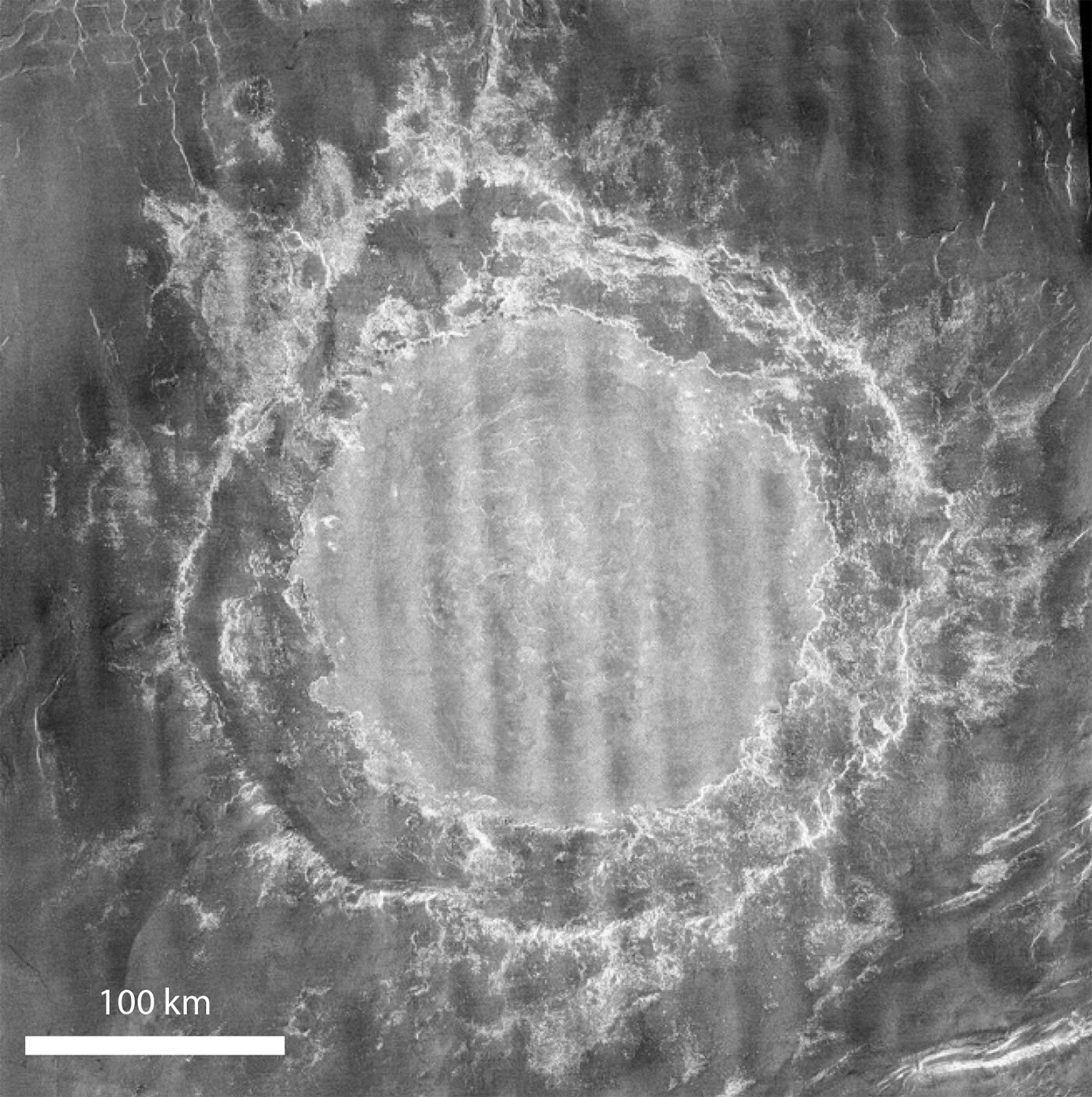
[ad_1]

Mead Crater, the largest impact basin on Venus, is surrounded by two rings of rock, which provide valuable information about the planet’s lithosphere. Credit: NASA
At one point, between 300 million and 1 billion years ago, a large cosmic object crashed into the planet Venus, leaving a crater over 170 miles in diameter. A team of researchers from Brown University used this ancient impact scar to explore the possibility that Venus once had Earth-like plate tectonics.
For a study published in Nature astronomy, the researchers used computer models to recreate the impact that carved out Mead Crater, Venus’ largest impact basin. Mead is surrounded by two cliff-shaped faults – rocky ripples frozen in time after impact forming a basin. Models showed that for these rings to be where they are in relation to the central crater, Venus’ lithosphere – its rocky outer shell – had to be thick enough, much thicker than that of Earth. This finding suggests that an Earth-like tectonic regime, where continental plates drift like rafts atop a slowly stirring mantle, was unlikely to be occurring on Venus at the time of Mead’s impact.
“This tells us that Venus likely had what we would call a stagnant lid at the time of impact,” said Evan Bjonnes, a graduate student at Brown and lead author of the study. “Unlike Earth, which has an active cover with movable plates, Venus appears to have been a single-plate planet for at least as far as this impact.”
Bjonnes says the findings provide a counterpoint to recent research suggesting that plate tectonics may have been a possibility in Venus’ relatively recent past. On Earth, evidence of plate tectonics can be found all over the world. There are huge cracks called subduction zones where bands of crustal rock are driven into the subsoil. Meanwhile, a new crust forms amid ocean ridges, winding mountain ranges where lava from the depths of the Earth sinks to the surface and hardens into rock. Orbital spacecraft data revealed cracks and ridges on Venus that look a bit like tectonic features. But Venus is enveloped by its thick atmosphere, which makes it difficult to make definitive interpretations of the fine surface features.
This new study is a different way of approaching the question, using the Mead impact to probe the characteristics of the lithosphere. Mead is a multi-ringed basin similar to the immense eastern basin on the Moon. Brandon Johnson, a former Brown professor who is now at Purdue University, published a detailed study of Orientale rings in 2016. This work showed that the final position of the rings is strongly related to the thermal gradient of the crust – the rate at which the temperature of the rock increases with depth. The thermal gradient influences how rocks deform and break as a result of an impact, which in turn helps determine where the basin rings end.
Bjonnes adapted the technique used by Johnson, who is also a co-author of this new research, to study Mead. The work showed that for Mead’s rings to be where they are, the crust of Venus must have had a relatively low thermal gradient. This small gradient – signifying a comparatively gradual increase in temperature with depth – suggests a fairly thick Venusian lithosphere.
“You can think of it as a frozen lake in winter,” Bjonnes said. “The water on the surface reaches the freezing point first, while the water at depth is a little warmer. When this deeper water cools to temperatures similar to those on the surface, you get a layer of thicker ice. “
Calculations suggest that the gradient is much lower and the lithosphere much thicker than you would expect for an active eyelid planet. This would mean that Venus has been without plate tectonics for a billion years, the first point at which scientists believe Mead’s impact occurred.
Alexander Evans, assistant professor at Brown and co-author of the study, said a compelling aspect of Mead’s results is their consistency with other characteristics of Venus. Several other ringed craters the researchers examined were proportionately similar to Mead, and the thermal gradient estimates are consistent with the thermal profile needed to support Maxwell Montes, Venus’ highest mountain.
“I think the discovery highlights the unique place that Earth, and its global plate tectonics system, has among our planetary neighbors,” Evans said.
Origin of the impact of Archean cratons: learning from Venus
E. Bjonnes et al, Estimation of Venusian thermal conditions using the morphology of cooking basins, Nature astronomy (2021). DOI: 10.1038 / s41550-020-01289-6
Provided by Brown University
Quote: Thick lithosphere casts doubt on plate tectonics in Venus’ geologically recent past (2021, January 28) retrieved January 29, 2021 from https://phys.org/news/2021-01-thick-lithosphere-plate -tectonics-venus.html
This document is subject to copyright. Other than fair use for study or private research, no part may be reproduced without written permission. The content is provided for information only.
[ad_2]
Source link